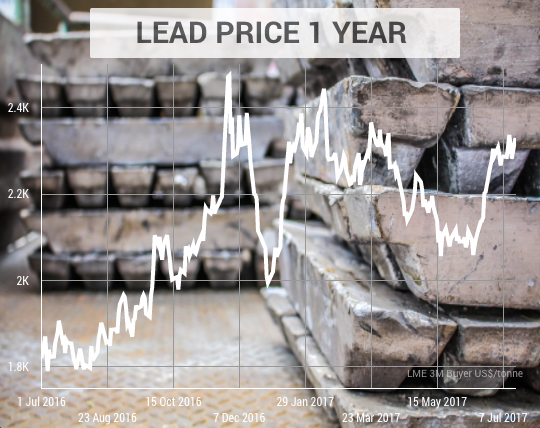The price of zinc continued its good run on Monday, rising to $2,825 a tonne after a report showed the market moving deeper into deficit. Zinc has advanced 10% year to date, building on a 60% rally in 2016, the best performing commodity of last year.
 The global lead market recorded a deeper deficit of 178,000 tonnes during January to end-May from 133,000 tonnes during the same period last year according to data from the Lisbon-based International Lead and Zinc Study Group released today.
The global lead market recorded a deeper deficit of 178,000 tonnes during January to end-May from 133,000 tonnes during the same period last year according to data from the Lisbon-based International Lead and Zinc Study Group released today.
For the first five months of the year, total reported inventories declined by 167,000 despite mine output increasing by 320,000 tonnes to 5.37 million tonnes from January to May, up 6.3% compared to 2016 as a result of higher production in Eritrea, India, Peru and Turkey that more than balanced reductions in Australia and the United States.
After a sharp fall in 2016, US apparent demand for refined zinc metal increased by 19% according to ILZSG. In China, apparent usage decreased by 2.8% and in Europe consumption rose 1.8%. On a global basis demand was a modest 1.1% higher.
Chinese imports of zinc contained in zinc concentrates totalled 477,000 a rise of 28% compared to the same period of 2016, but the country’s net imports of refined zinc metal decreased by 48% to 129,000.
The price of lead, often a byproduct of zinc mining, also gained on Monday, rising to $2,330 a tonne after the release of the ILZSG study. Lead is up 17.5% in 2017 and 13% over the past month.

The global lead market widened its deficit to 30,100 tonnes in May from 7,700 tonnes in April. For the first five months of the year, the lead market experienced a deficit of 91,000 tonnes, compared to a surplus of 45,000 tonnes in the same period last year.
Mine output increased to 2.15 million tonnes from January to May, up nearly 13% compared to 2016 mainly due to higher output in China and India that more than offset decreases in Australia and Peru.
Total global refined output reached 4.88 million tonnes, an increase of 7%. Consumption jumped by more than 10% to 4.97 million tonnes.
The prices of lead and zinc have been supported by mine supply constraints brought on by permanent closures due to resource exhaustion, as well as discretionary closures and downscaling in Canada, Peru and Australia by top zinc miner and trader Glencore.